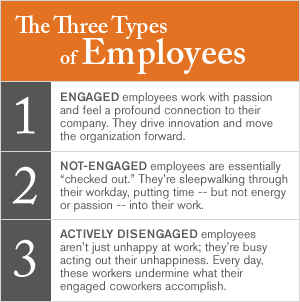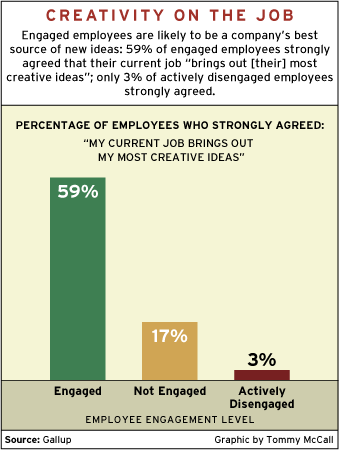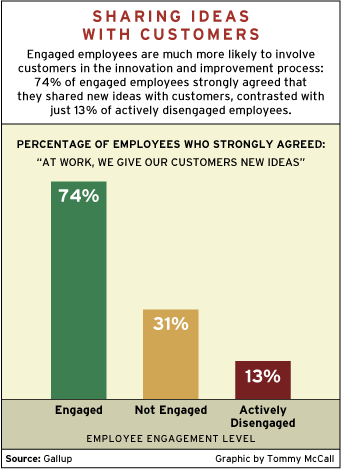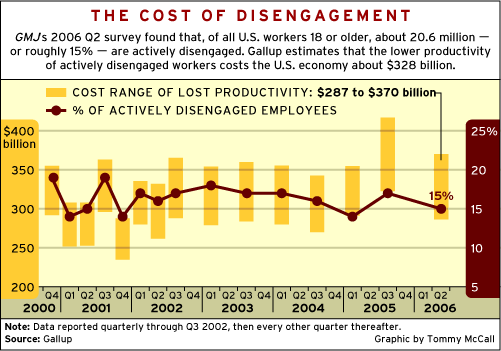Is innovation important? Over the past several years, business articles and research studies have stressed its significance in creating long-lasting competitive advantage and achieving dramatic increases in organizational performance. In the February 2006 issue of Harvard Business Review, author Gary Hamel writes that internal business process and management innovations over the past century "have created more competitive advantage than anything that came from a lab or focus group."
A recent survey of more than 750 CEOs showed that business leaders agree with Hamel's thinking. This study by IBM Consulting Services revealed that company leaders are increasingly focused on innovation as a key mechanism for driving growth. CEOs said they were looking for creative business models and new ideas in products, services, and markets. The CEOs also emphasized the need to look outside the company -- including among business partners and customers, the top source of new ideas -- as well as inside the company for innovations.
In other words, when it comes to innovation, business leaders aren't necessarily looking to traditional sources, like research and development departments, to contribute big new ideas; they're counting on ideas from their employees, customers, and partners to help drive the organization forward. And engaged employees are most likely to contribute those innovations, according to a recent ���۴�ýManagement Journal ( GMJ) study.
Encouraging creative ideas
 |
GMJ surveyed U.S. employees to discover what effect employee engagement may have on team-level innovation and customer service delivery. ���۴�ýresearchers studied employee responses to several items about innovation in the workplace to see which factors differed most strongly among engaged employees (29% of respondents) and those who were not engaged (56%) or actively disengaged (15%). (See graphic "The Three Types of Employees.")
���۴�ýresearch has shown that engaged employees are more productive, profitable, safer, create stronger customer relationships, and stay longer with their company than less engaged employees. (See "Feedback for Real" in the "See Also" area on this page.) This latest research indicates that workplace engagement is also a powerful factor in catalyzing "outside-the-box" thinking to improve management and business processes as well as customer service.
When GMJ researchers surveyed U.S. workers, 59% of engaged employees strongly agreed with the statement that their current job "brings out [their] most creative ideas." On the flip side, only 3% of actively disengaged employees strongly agreed that their current job brings out their most creative ideas. (See graphic "Creativity on the Job.")
 |
The study also showed that engaged workers were much more likely to react positively to creative ideas offered by fellow team members. When asked to rate their level of agreement with the statement "I feed off the creativity of my colleagues," roughly 6 in 10 engaged employees (61%) strongly agreed, while only about 1 in 10 actively disengaged employees (9%) gave the same answer. This suggests that higher levels of employee engagement not only increase the likelihood that individual employees will generate new ideas, it also suggests that idea generation among engaged employees can be amplified when it occurs in a team setting.
GMJ researchers also explored the role that workplace friendships play in promoting innovation. About three-fourths of engaged employees (76%) strongly agreed with the statement "I have a friend at work who I share new ideas with." On the other hand, only 2 in 10 actively disengaged employees (21%) strongly agreed that they have a friend at work with whom they share new ideas. Clearly, friendships do play a significant role among engaged employees when it comes to setting the stage for idea creation and refinement. (See "Wanted: More Conversations in the Workplace" in the "See Also" area on this page.)
The results also suggest that there are significant differences in how engaged and actively disengaged employees view their company's encouragement and acceptance of innovative ideas. Only 4% of actively disengaged employees strongly agreed with the statement "My company encourages new ideas that defy conventional wisdom," while more than half of engaged employees (55%) strongly agreed that their company encouraged such ideas.
Innovation and customer service
GMJ researchers also investigated the effect of employee engagement on customer service innovation. Nearly 9 in 10 engaged employees (89%) strongly agreed that "At work, I know where to go with an idea to improve customer service," contrasted with only 16% of actively disengaged employees.
Engaged employees also involved customers in the innovation and improvement process. When asked to rate their level of agreement with the statement "At work, we give our customers new ideas," 74% of engaged employees strongly agreed that they shared new ideas with customers, contrasted with just 13% of actively disengaged employees. (See graphic "Sharing Ideas With Customers.")
 |
Gallup's employee engagement research has consistently shown a connection between employee engagement and customer engagement. One factor that can influence customer engagement is an employee's willingness to change -- or to "learn and grow" -- to meet the customers' changing needs. When ���۴�ýasked workers to rate the statement "I have grown in my ability to positively affect our customers," the results were telling. Almost 9 in 10 engaged employees (85%) strongly agreed that they have grown in their ability to positively affect their company's customers, while only 2 in 10 actively disengaged employees (19%) strongly agreed.
Finally, more than half of all engaged employees (51%) strongly agreed with the statement "At work, my coworkers always do what is right for our customers." This was in stark contrast to the actively disengaged employees: Only 1 in 10 strongly agreed that their coworkers always do what is right for their customers.
Gallup's research into the relationship between employee engagement and innovation strongly indicates that engaged employees are far more likely to suggest or develop creative ways to improve management or business processes. They're also far more likely to find creative ways to solve customer problems or to involve their customers in creating service innovations. Company leaders who want to drive growth through innovation should first create an environment that welcomes new ideas -- and should make engaging employees a key component of that strategy.
 |
Results of these surveys are based on nationally representative samples of about 1,000 employed adults aged 18 and older. Interviews were conducted by ���۴�ýby telephone quarterly from October 2000-October 2002, then semi-annually thereafter. For results based on samples of this size, one can say with 95% confidence that the error attributable to sampling and other random effects could be plus or minus three percentage points. For findings based on subgroups, the sampling error would be greater.